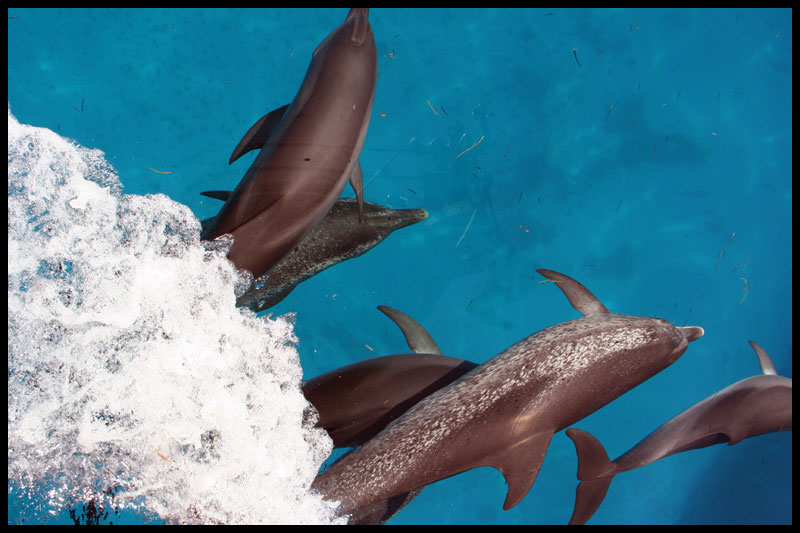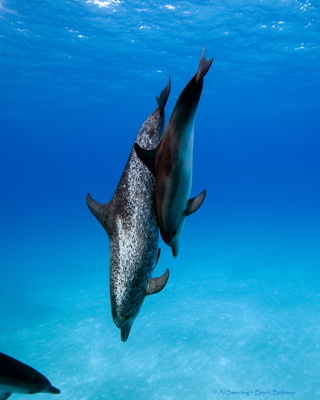 |
Anything you can do I can do better!




|
The Atlantic spotted dolphin, like
many other species of dolphin, has evolved adaptations to survive in its
environment. The major adaptation is echolocation.
Echolocation informs the dolphin of a certain object's shape, size,
density, and other vital details about the object.
Echolocation consists of many different clicks and whistles that can be
performed above and below water. Each specific spotted dolphin has
its own specific click that can identify the individual.
Echolocation is used
also to view the dolphin's surroundings. The clicks and whistles
bounce off of objects that are essentially in the dolphin's path.
The clicks that bounce off the object head back to the dolphin, where
they are "decoded" and the dolphin learns what the object is. If a dolphin emits a few
clicks per second, you would hear a low pitch sound. If a dolphin
emits many clicks per second, you would hear a high pitch sound.
Communication is key to dolphins finding
food, avoiding predators, mating, and swimming together.

Another important adaptation is what they look like. The bodies of
these dolphins are streamlined so they can
swim extremely fast and swiftly through the
water.
Their tail is the strongest part of their body. It propels them through
the water and in turn allows the dolphin to swim, jump, leap, and other
acrobatics. The coloring on these dolphins changes over time.
Calves
are born gray with no spots and a white belly. This coloring looks very
similar to their cousin, the
Bottlenose dolphin.
Their coloring changes to a two-tone gray with the dark gray on top and
the light gray on bottom and still no spots
as the calf grows older. As an "teenage" dolphin, spots begin to appear
on the lower part of the body. As time goes on, lighter spots begin to
appear on the upper body. Older dolphins sometimes have the appearance
of a solid color underbelly because the spots tend to almost merge into
a solid color. Both of their eyes are circled in black. All this
coloring adds to camouflage and the ability to almost not be seen.

There are many other adaptations this species of dolphins utilizes. The
Atlantic spotted dolphin can hold its breath for seven minutes, on
average. Their
feeding
patterns have adapted to the way their prey reacts when they arrive.
Atlantic spotted dolphins feed on schools of fish, most often tuna and
herring. In schools, there is always more food than needed, so the
dolphins do not go hungry. The teeth of the Atlantic spotted dolphin
grasps the prey and swallows it whole, head first. The way these
dolphins catch their prey goes as follows. First, the pod spreads out,
using echolocation to find a school of fish. Searching as a pod is much
more efficient because more individuals are looking for the prey.
Atlantic spotted dolphins sometimes mix with pods of Bottlenose dolphins
and common dolphins when they are looking for food. Once the prey is
found, they herd the fish in a circle and stun them with the fast paced
sonar. Then the Atlantic spotted dolphins feed in groups so that the
fish do not get away. The Atlantic spotted dolphins continue these
steps until all have eaten.
Go back home
Find out more on
what they eat
| 
|

|
 |